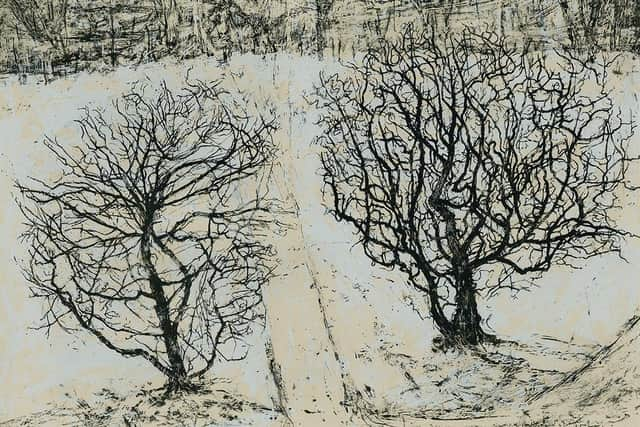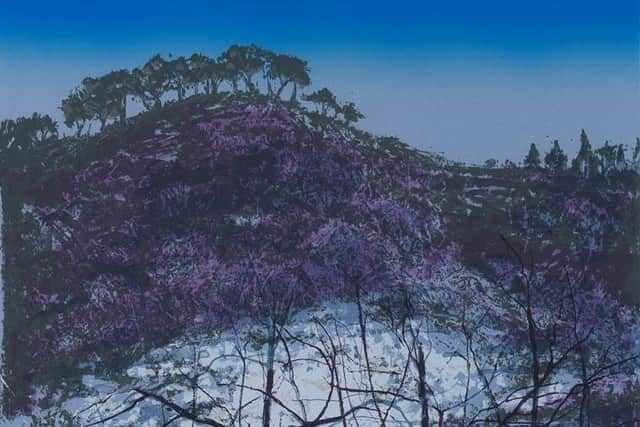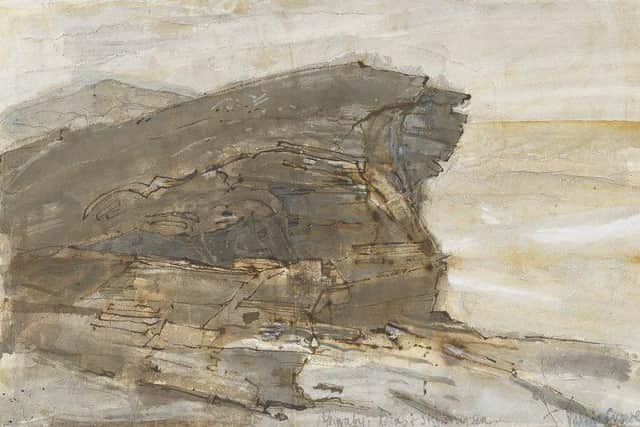Art reviews: Victoria Crowe | &Gallery Winter Exhibition | Gerber Fine Art Winter Collection
Victoria Crowe: Low Winter Light, Scottish Gallery, Edinburgh *****
&Gallery, Winter Exhibition, Edinburgh ****
The Winter Collection, Gerber Fine Art, Glasgow ****


Victoria Crowe’s art is rich and diverse. The exhibition of her portraits a few years ago at the Scottish National Portrait Gallery showed what a distinguished recorder of our contemporaries she has become. She has also proved herself one of the finest modern painters of Italy and of Venice in particular, but the Scottish landscape has also been a consistent theme in her work and she has brought something quite new to it. For many years her principal inspiration has been the landscape around her home under the steep-sided Pentland Hills and the homes that she and her husband have chosen have over time successively lain further south-west of Edinburgh. The land here is high, too. West Linton where they now live is nearly a thousand feet above sea level. At that altitude here in Scotland, when winter turns severe, as it often does, we are reminded how close we are to the Arctic. The stark austerity of this winter landscape was an early theme in her work and it still is. It was above all this winter landscape that inspired the memorable series of pictures that she called A Shepherd’s Life.
Advertisement
Hide AdThe Northern winter’s special poetry is celebrated again in both the title and the work in Low Winter Sun, her new exhibition at the Scottish Gallery. In a print called Stillness, for instance, bare trees silhouetted against snow echo the monochrome winter landscapes of the Shepherd’s Life pictures. Indeed, bare winter trees have been a theme in her art for some time. Often too they are depicted catching that low winter sun. Here though she works several new variations on this theme. A series of monotypes here is particularly striking. The technique she uses gives freedom and informality to what are in effect portraits of winter trees. In one of them, as the title Warm Winter Light implies, the austerity of the image is softened by the colour of the light, but Edge of the Night and Night Forest are sterner. In them a single tree in the foreground catches the light, but the background, as it also is in Edges of the Night and Lights in a Mysterious Landscape, is a gloomy forest, dark and sinister as any conjured by the Brothers Grimm.
Though it is less sinister, one particularly striking print, Resilient Tree, Rising Moon – a typically inventive combination of woodblock, screen print and lithograph – does indeed have a fairytale magic about it. It is a portrait of an ancient tree with a knobbly trunk and spreading, twisted branches which seem to have caught the moon in their tangle. Almost animate, it is a little bit like a fairy tree drawn by Arthur Rackham.
Following the winter theme there are also beautiful watercolours of frosted windows looking out onto the wintry garden in West Linton. Winter Landscape Nine Mile Burn is a monotype of a frosty landscape seen through a screen of black branches. Another monotype, First Snow Mirrored, seems to use one of her favourite devices, the silvery light of the reflections in an old mirror. These and other pictures are identifiable, if not by title, like The Hill, West Linton, for instance, then at least by the subject matter, as painted near her home. A scarlet maple, its bare branches seen against darkness, is however a tree in Edinburgh.


At the Still Point of the Turning Year, a beautiful picture of trees against a hill with a deep blue sky above, seems to be back under the Pentlands, but she turned for its title to TS Eliot invoking the winter solstice. A couple of lines later, Eliot writes memorably “At the still point, there the dance is.” It could be the text for a new body of work in the show inspired by the landscape of Orkney. In 2022, with a fellowship from the RSA, the artist stayed twice on the islands, based variously in Stromness and on Birsay. For these visits she chose the two still points of the turning year, staying first in June at the summer solstice and then again in November, close to the winter solstice. The work she produced on both occasions, or from studies she made, is beautiful.
There are sketches here made on the coasts. A photograph shows her nonchalantly sitting drawing at the top of a towering cliff above the sea, but mostly it seems she looked up at the sky. There are several small works that record the high night skies of summer where even at midnight the light in the north reveals the presence of the sun just beneath horizon. The title of one, Return from Stromness, Midnight Dawn, recalls this spectacle of the northern summer precisely in its title.
Winter, however, seems still to be her favourite season and it was the sight of the full moon lighting the winter darkness that really caught her imagination. The result is The Moon Sequence, a group of small paintings, outstandingly beautiful even here. Dovecot Studios has also turned one of these small pictures, not into a tapestry exactly, but into a tufted rug. Less laborious than tapestry, this process nevertheless calls for the same subtlety and judgement in translating a work of art into a very different medium. The way the picture has scaled up beautifully is testimony to the strength of this image and by extension the others like it. This is a poetic and very distinguished show.
Advertisement
Hide AdHoping to catch the seasonal market, Christmas is a time when the galleries tend to show miscellanies. They are not always interesting, but this year &Gallery has made a show that includes a single work by each of the gallery’s 28 artists. You might find that Christmas present here, but even if you don’t the show gives an intriguing profile of this adventurous gallery. The works are mostly abstract, if in different ways. They include the luminous abstract canvasses of James Lumsden, Eric Cruikshank and Michael Craik. There are also more geometric but equally abstract works by Laura Jane Scott, Jon Thomas, Molly Thomson, and Susan Laughton. There are however also landscapes by Andrew Mackenzie and Anke Roder. The veiled sky of Mary Morrison’s Phosphorescent is something in between abstraction and landscape. Altogether it is a diverse and interesting group.


In Glasgow, Gerber Fine Art caters for a different taste with a remarkable exhibition of more classic art including paintings by Anne Redpath, Joan Eardley, John Houston and Bet Low as well as beautiful drawings by James Cowie, Leslie Hunter, William McCance and many others. The whole show is available online but in the gallery with limited space it will change from time to time. Either way it's a great Christmas opportunity.
Victoria Crowe and &Gallery Winter Exhibition until 23 December; Gerber Fine Art Winter Collection until 28 January